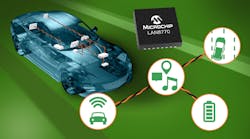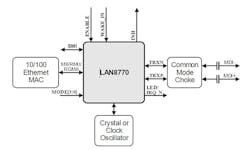Tiny Automotive Ethernet PHY Transceiver Does the “Big Sleep,” Wakes Up Big Time
If you had predicted as the 20th century ended and the 21st century began, that cars would be laced with a multitude of networks including Ethernet in a few decades, you would have been called a visionary or a dreamer, or perhaps both. Now, in 2020, we know how that prediction turned out, with automobiles containing multiple low-, medium-, and high-speed networks for internal and external connectivity.
Such an abundance has created new design issues, as having all their constituent components “always on” isn’t a desirable characteristic due to power constraints. Thus, these networks prefer to have some segments in deep hibernation with quick wake-up capability on demand as needed.
To address these needs, Microchip Technology introduced the LAN8770, an OPEN Alliance TC10 sleep-standard Ethernet physical-layer transceiver (PHY) with sleep current of less than 15 µA, which the company claims is about one-quarter the value of comparable available devices. (If you’re not familiar with the OPEN Alliance TC10 special interest group, there’s information here and here.)
The single-port 100BASE-T1 Ethernet PHY (see figure) is compliant with the IEEE 802.3bw-2015 specification and available in a 5- × 5-mm or 6- × 6-mm wettable-flanks QFN package. Along with power and speed, a small package is a necessity for space-constrained applications such as the infotainment head unit, telematics modules, or advanced driver-assistance systems (ADAS).
It provides 100-Mb/s transmit and receive capability over a single unshielded twisted pair (UTP), exceeds automotive electromagnetic interference requirements, and is Grade 1 (−40 to +125°C) automotive AEC-Q100-qualified. In addition, the LAN8770 is Microchip Functional Safety Ready. It’s specifically designed to simplify customers’ end-product ISO26262 safety certification with the support of specialized hardware safety features; Failure Modes, Effects, and Diagnostic Analysis (FMEDA); and safety manual.
This extreme emphasis on low sleep current may seem misplaced and perhaps even disproportionate in the context of overall automotive power usage, but it is not. “Typically, an automotive module can only consume 100 microamps maximum in sleep (battery) mode, so if the PHY alone consumes north of 50 microamps, additional circuitry is required to avoid exceeding the target power budget,” said Charles Forni, vice president of Microchip’s USB and Networking business unit. “Often, applications add an additional wire or CAN bus just to enable and disable the power. Our PHY avoids such a need, minimizing components, installation, and cost.”
There are presently two LAN8770 devices: the LAN8770M and LAN8770R. The LAN8770M supports communication with an Ethernet MAC via standard MII/RMII, while the LAN8770R supports it via MII/RMII/RGMII interfaces. An optional 125- or 50-MHz reference clock output is also provided for RGMII and RMII applications, which often makes it possible to eliminate an external reference clock. Power efficiency is further enhanced with optional integrated linear regulator and Microchip’s flexPWR technology for variable xMII and input/output supply voltages, providing flexible design options and more opportunities to save power.
For today’s designers, component selection is often as much about development and evaluation tools as it is about the component itself, given time-to-market and design-qualification pressures. For these ICs, advanced PHY diagnostics supply the user with troubleshooting capabilities through Microchip’s integrated LinkMD cable diagnostic system designed to detect cable defects, shorts, or opens. The device also provides a receiver Signal Quality Indicator (SQI), overtemperature and undervoltage protection, and comprehensive status interrupt support along with various loopback and test modes.
The PHY family is backed by Microchip’s free LANCheck online design service that reviews customer designs, ensuring best design practices are used. AUTOSAR, Linux, and RTOS software drivers are available, too, as is a separate 100BASE-T1 to 100BASE-TX Media Converter evaluation kit. A 100BASE-T1 daughtercard evaluation board is also available for use with Microchip’s ATSAMV71-XULT Xplained Ultra microcontroller kit and the SAMA5D3-EDS microprocessor kit. More information on the LAN8770 is available in the product brief.

